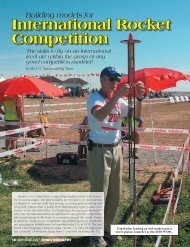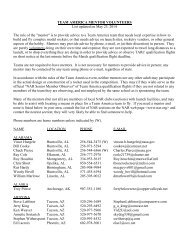Modular rockeTs Building Baffles - National Association of Rocketry
Modular rockeTs Building Baffles - National Association of Rocketry
Modular rockeTs Building Baffles - National Association of Rocketry
You also want an ePaper? Increase the reach of your titles
YUMPU automatically turns print PDFs into web optimized ePapers that Google loves.
The Cato ChroniclesThe Great TARCMigrationThere are many examples <strong>of</strong> migrationin nature. Moose migrate across the Arcticin search <strong>of</strong> food and mates. Salmon spendtheir lives in the Atlantic or Pacific Oceans,only to return to the rivers where they werespawned to lay eggs and die. Swallows returnto the Capistrano Mission in San Juan,California, on or around March 19 <strong>of</strong> everyyear. And model rocketry has its own migrations,with one <strong>of</strong> the largest being theGreat TARC Migration every spring.In the fall and winter <strong>of</strong> the year, it’s notunusual to see the odd teenager or two atlaunches (and let’s face it, most teenagersare odd), but they’re almost never seen inlarger numbers. However, with the lengtheningdays <strong>of</strong> spring come the TARC teams.At first only one or two teams show up, ledby adults who struggle valiantly to keepsome semblance <strong>of</strong> order in the group. Butas the deadline for qualified flights drawsnear, more and more teams arrive, until theflying field is overrun by these newcomers.You see strange hats worn at all sorts<strong>of</strong> odd angles, colorful but mismatchedclothing, and baggy pants that are hangingso low that several inches <strong>of</strong> underwearcan be seen. But the TARC teams seemnot to mind the way that the older rocketeersare dressed. They just chatter amongthemselves, wandering around the flightline,and occasionally manage to launch arocket.Almost every TARC team has certainindividuals in it. First is the adult super-by Leslie Houk NAR 58525visor or mentor, who is easily recognizedby his constant nervous twitches, strainedvoice, and wild staring eyes. In all honesty,dealing with the average group <strong>of</strong> teenagersis stressful enough to begin with,and adding flammablemodel rockets to the mix has causedthe most hardened <strong>of</strong> individuals to have anervous breakdown.Second are the nerds, who probablygot their school interested in the TARCprogram to begin with. They will be wearingT-shirts with pictures <strong>of</strong> Japanese cartooncharacters, quotes from little-knowncult motion pictures, or obscure technical“jokes” that only make sense to computerprogrammers. Sometimes they are modelrocketeers, but sometimes they are computernerds who don’t know which end<strong>of</strong> a motor the igniter goes in. They willbe the ones doing all the actual work <strong>of</strong>launching the rocket.Next are the kids who were ordered toattend by their teachers, guidance counselors,or parole <strong>of</strong>ficers. They will be wearinghoodies in 90+ degree weather, willhave multiple piercings, and their shirtswill <strong>of</strong>ten have language printed on themthat can’t be repeated in a family magazine.They don’t want to be there, they’re certainthat they are much cooler than anyoneelse there, and they’re useless at getting anywork done for the team. They usually windup later in life becoming politicians.Incidentally, you can always tell a newteam that has never actually launched amodel rocket before. They’re the ones thatbelieve the computer simulations they’verun are infallible, and don’t understandthat “marginally stable” means that youcan’t fly your rocket in a 40 mph wind.Their rockets tend to have little stubs forfins, and they’re always surprised whentheir rockets cartwheel across the sky inthe slightest breeze.But all migrations eventually come toan end, and the TARC migrations are nodifferent. After the TARC cut<strong>of</strong>f date, allthe teens mysteriously disappear. Wherethey go, no one can say. Some say they flysouth for the winter, while others claimthey ride the Gulf Stream currents to theirsummer mating grounds, but both <strong>of</strong> theseare only likely for those whose parents arewealthy enough to send them. All the restdisappear to realms unknown when theshortening days signal the beginning <strong>of</strong>autumn. The launch ranges are left to theadults, who return to their timeless routines<strong>of</strong> prepping, launching, and retrievingrockets. They wait patiently for the seasonsto turn, and for the spring to heraldthe upcoming return <strong>of</strong> the young in nature’seternal dance <strong>of</strong> life.But there are always a few teams whosemembers absorb the knowledge and havethe skills to make a serious bid for the prize.Their model flies well, and they develop anenthusiasm for model rocketry that carriesover after TARC is done. They become regularsat launches, and start winning competitions.It’s very annoying.This column is based on an idea byAndy Eng.36 MAY/JUNE 2010 Sport <strong>Rocketry</strong>Sport <strong>Rocketry</strong> MAY/JUNE 2010 36
















